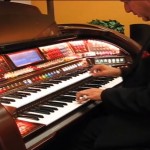 https://www.youtube.com/watch?v=K_nKFBVT-_g
https://www.youtube.com/watch?v=K_nKFBVT-_g
According to Ralph W. Emerson, “All of Nature is a metaphor of the human mind.†If this is so, perhaps the same can be said for music or; perhaps the evolution of music mirrors the evolution of the human brain.
Although some of the art that appeared on cave walls at least 40,000 years ago depicts people dancing, there is no record of when music began. Some believe that the first music, “motherese,†might have been hummed by a mother while rocking her newborn baby in her arms. Others believe that it may have begun as screams of fear, agony or triumph. Some believe that music predated the onset of languages which might explain why some people are profoundly moved by opera productions. Whatever the origin, man has learned much about music from nature.
Alfred Wallace showed that ancient tribes, some of which date back over 60,000 years, used music in many rites and rituals. Understandably, they lacked the knowledge, materials and tools to craft complex instruments, but could whistle, hum, chant and bang sticks and rocks together. Eventually, drums were created, and reeds, willow branches and bamboo stems produced a variety of pipes. One of the most sophisticated “primitiveâ€instruments was made by connecting several different lengths of bamboo together and producing the “pan flute.†It is intriguing that many of these instruments produced tonic scales that are universal to all music. Larger sticks were hollowed out to make early flutesand recorders. Animal hides were used for drums, and animal small intestines were stretched on sticks or gourds to create primitive “guitars†and lutes. As people discovered how to fire clay, they made ocarina-like instruments that produced several notes.
When metals were discovered, a whole new plethora of instruments evolved including brass flutes, saxophones and horns. When electronics was added, another musical leap was made in tone variation and amplification. Electric guitars, pianos and organs became available, but in 1964 Dr. Robert Moog invented a synthesizer that created “new-age-music,†totally synthetically.
For nearly 100 years, the Lowrey Organ Company has been manufacturing electronic organs. Their latest is a state-of-the-art, digitally wired, organ. I can not attest to its tonal accuracy except to note that on some blind tests, many are not able to tell the difference between the “fake†and real instruments. What is amazing, however, is that it has 459 “voices,†6 organ types, 319 styles and an amazing 8,410 presets. It is possible to produce music, from silly to sacred, in 1650 genres.
It has been said that imitation is the highest form of flattery, and in this video the musician playing “The Lonely Shepherd†is embellishing the original theme by interpreting, improvising and creating new variations.
Zamfir’s beautiful version of “The Lonely Shepherd,†played on a pan flute, compared to the same song played on the Lowrey Organ, represents a span of over 1000 years.It is intriguing to wonder what man and his music will evolve into over the next 1000 years.